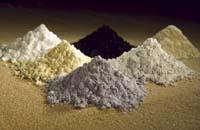Heavy metals on planet Earth
2007/06/01 Txintxurreta Agirre, Arantxa - Elhuyar Zientziaren Komunikazioa Iturria: Elhuyar aldizkaria
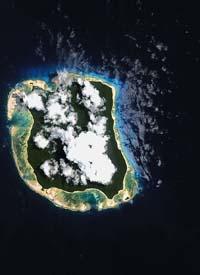
In the center of the Earth, 3.000 km from the surface, is the nucleus. The core is a dense, warm area of 3,485 km radius, made up of heavy metals, mainly iron and nickel, although it also contains traces of other metals such as copper.
On the terrestrial surface, however, there are few heavy metals. The most abundant chemical elements are oxygen and silicon, however much they are, and the most abundant heavy metal is iron, the rest of heavy metals appear in very small proportions on surface. The man long ago appropriated the properties of iron and exploited it. However, it is difficult to find iron in a natural state as a free element and, in most cases, forms compounds with other elements. The most common way to explain heavy metals is the formation of mineral compounds. Thus, among other things, there is copper in the malachite, lead in the galena, vanadium in the patronite and chromium in the chromite. However, minerals form rocks and, to a greater or lesser extent, heavy metals appear in all types of rocks.
In igneous rocks (due to the solidification of the magma) is common the presence of concentrations of metals such as gold, platinum, uranium, copper, chromium and vanadium, selenium and others. Nor is it rare that gold is in metamorphic rocks (originated by high pressures and temperatures), but it is a rock
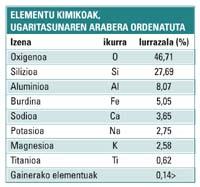
It also appears in large quantities in sediments (rocks originating after sedimentation). Also in this type of rocks are aluminum, platinum and iron, among others.
This type of rock is found all over the world and, when the concentration of heavy metals is high, they are exploited by humans through the formation of mines.
Euskal Herria
In the Basque Country, the most abundant and most exploited metal is, without a doubt, iron. In the first century BC, the old Pliny realized this and affirmed that "by the sea of Bizkaia there was an iron mountain." And so it was. In the mountains of Triano and Galdames was extracted abundant iron, forming around it a powerful industrial chain that has survived until recently. In Euskal Herria mining had a singular importance on the left bank of the Nervión river.

Silver and iron also came out in Irati, and they were often used to supply Orbaitzeta's weapons ironwork. In Aralar came the copper and in the area of Eibar, where there was also lead. There were also more copper, around Atxondo and Axpe. Lead and zinc have been extracted from the Cretaceous rocks in eleven areas of the Basque Country, such as Carranza, Mañaria, Atxondo, Aulesti, Berriatua, Itziar, Aizkorri, Legorreta, Barande, Araiz, etc.
We cannot forget, however, a special heavy metal that has not been exploited by the industry, the one that surrounds us: the iridium. Visible on the coast. This layer is found all over the world, but in few places it appears as on the coast of Biscay, Gipuzkoa and Labortana. Geologists from all over the world usually come to see this fine and whitish line.
The iridium is a heavy metal with the symbol I. Despite being abundant in the cosmos, on Earth the metal is very scarce. In the rocks between the Cretaceous and the Tertiary, however, a thin layer of great concentration of iridium appears. According to a theory, this iridium comes from space, it is brought by a meteorite. According to this idea, 65 million years ago, a large meteorite hit the Earth and the collision caused the release of dust into the atmosphere. Gradually, the suspended particles in the air, which were enriched with the iridium, were deposited on the ground and covered everything. This deck is what we currently see on the coast: Sopelana, Zumaia, Bidart... This theory is used to explain the disappearance of dinosaurs.
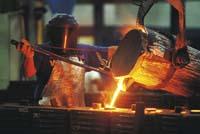
Mines of the world
Iron is typical of Euskal Herria, but it is also common throughout the world. It is the most abundant in heavy metals, as indicated above. However, in Euskal Herria it appears forming compounds, while in the west of Greenland the iron is loose. In meteorites, iron is also usually loose, sometimes alloy with nickel. The most common iron minerals are hematites, but others such as goethite, magnetite, siderite and limonite are also exploited. The oldest known mine dates back some 50,000 years, according to carbon 14, and is located in Swaziland, Africa. It is believed that the man of the Paleolithic drew from there hematites to form pigments with iron.
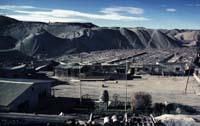
Titanium is more abundant and is the ninth most abundant chemical element on the earth's surface. It is a heavy metal for some. This is the element chosen by Frank Gehry for the Guggenheim in Bilbao. It is found in most igneous rocks, but it is never free. Anatase, brookite, ilmenite, leukoxene, titanite... are the most common minerals. There are important titanium stores in Australia, Scandinavia, the United States and Malaysia.
Abundant mineral is exploited in South America. Mexico, Peru, Chile and Brazil are the countries with the highest production. The richest mine in the world is located in Mexico. In Mexico there are also important mines for the extraction of lead, zinc and gold. For its part, Chile has the largest copper exploitation in the world and Peru is the country that houses the largest gold mine in South America...

Although most elements appear to form chemical compounds, the few heavy elements that appear in freedom have a special value for the human being. Among them are gold, silver and copper (there is also platinum, mercury and lead, but they are scarce).
The man first discovered free metals. They were free, for example, the golden pipes in the streams, which caused the fever of gold. But what is easy to find, also to get lost; finding free elements is therefore rare.
Biocentric approach
Although the proportion of heavy metals on Earth is not high, it is clear that they are of human interest and exploits them. But he does not stay alone in desire. The metallic core of the Earth creates a magnetic field that allows life: the so-called magnetosphere surrounds the Earth and protects it from solar storms. Moreover, the human being and the rest of the living beings are essential for the life of heavy metals, since they intervene in their basic functions.


Gai honi buruzko eduki gehiago
Elhuyarrek garatutako teknologia




